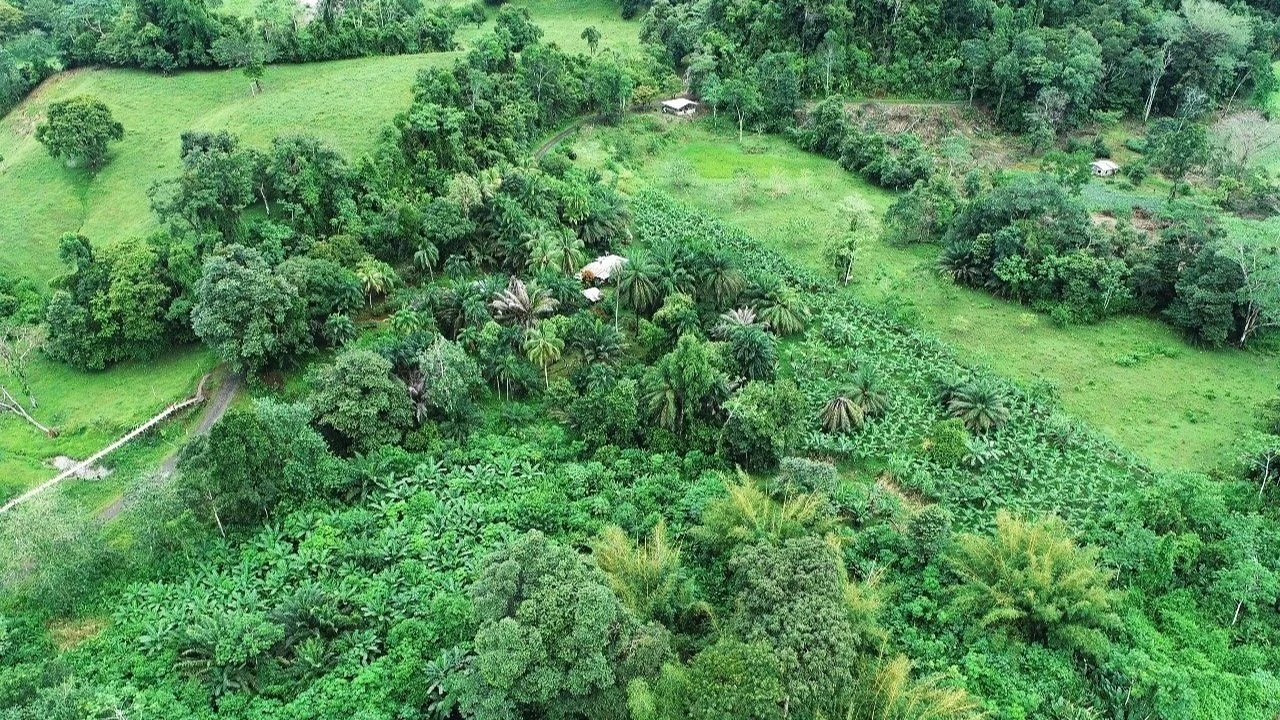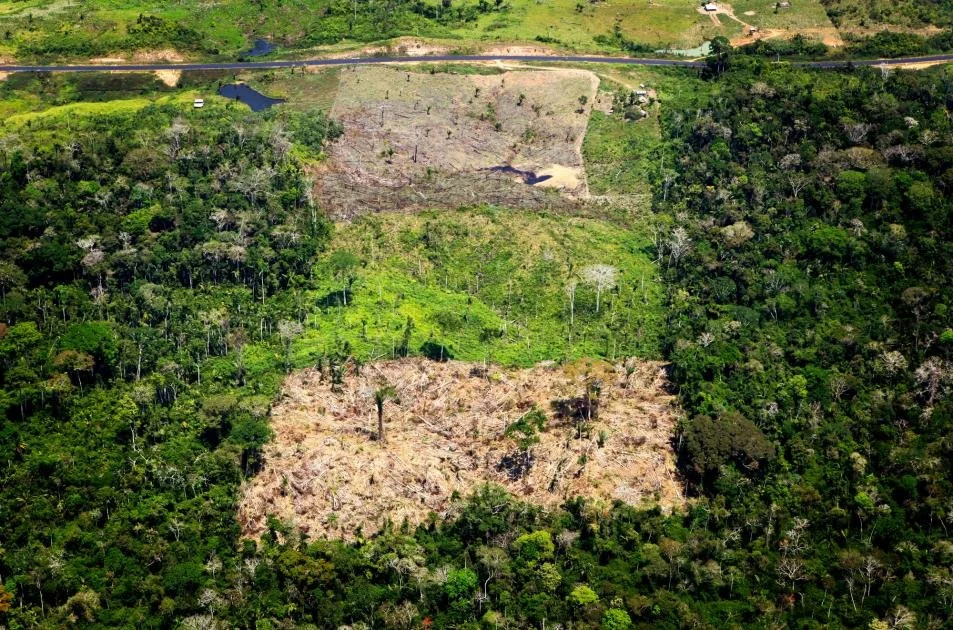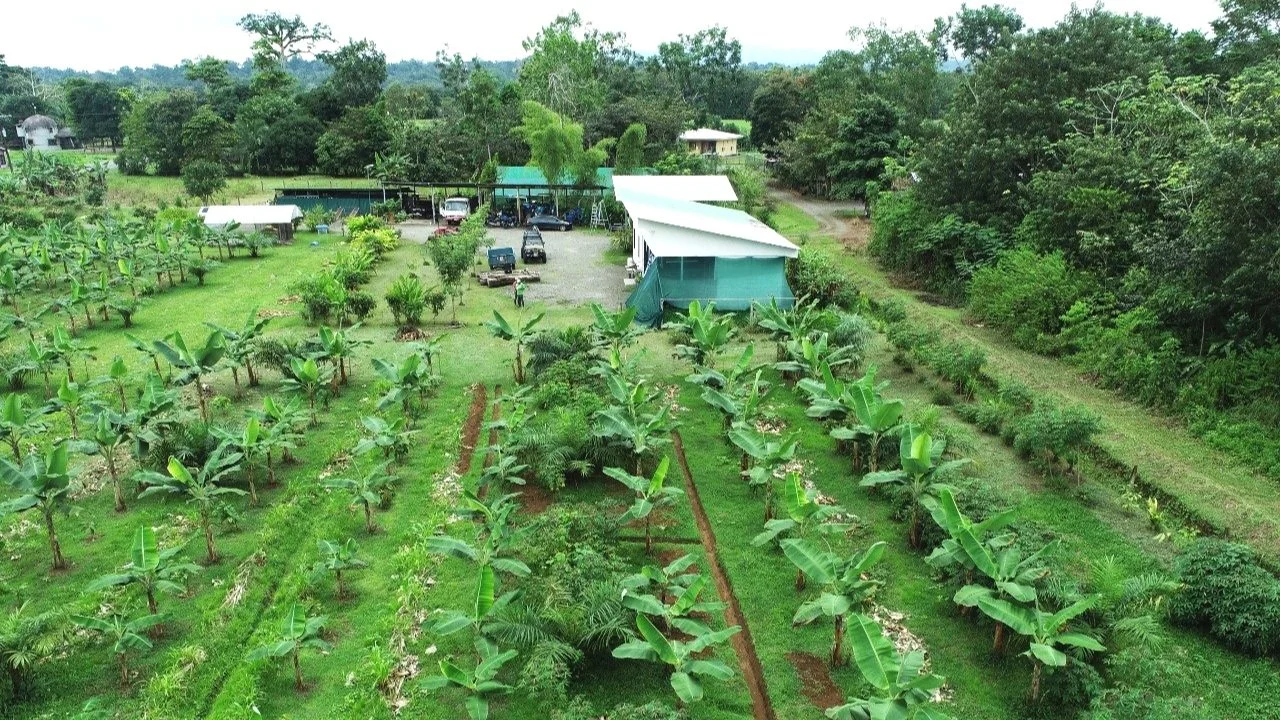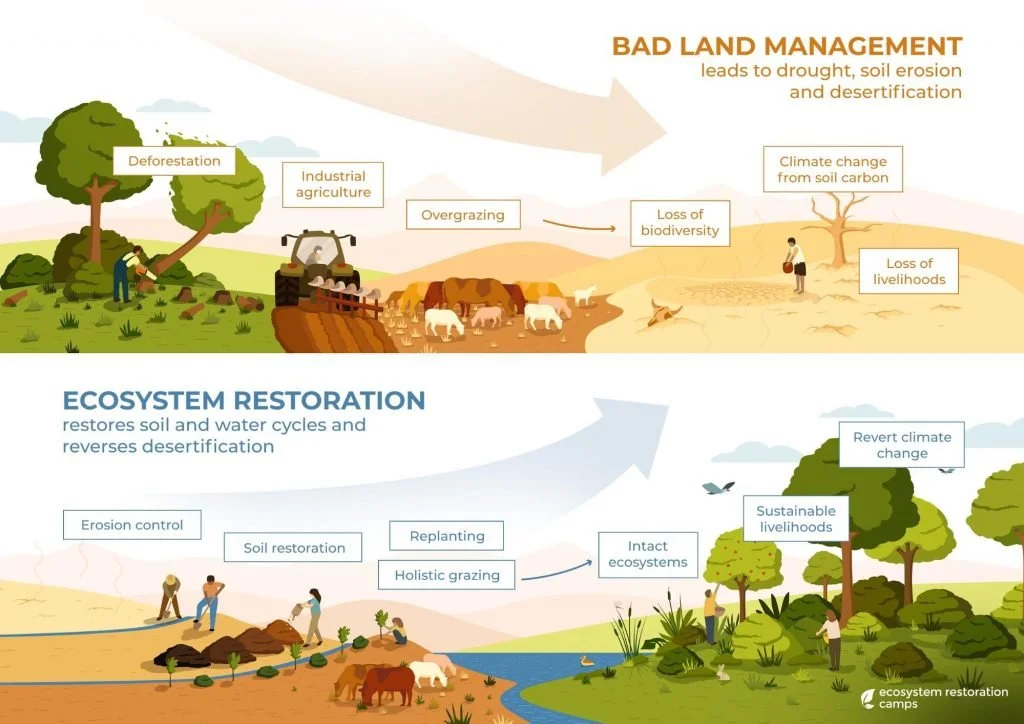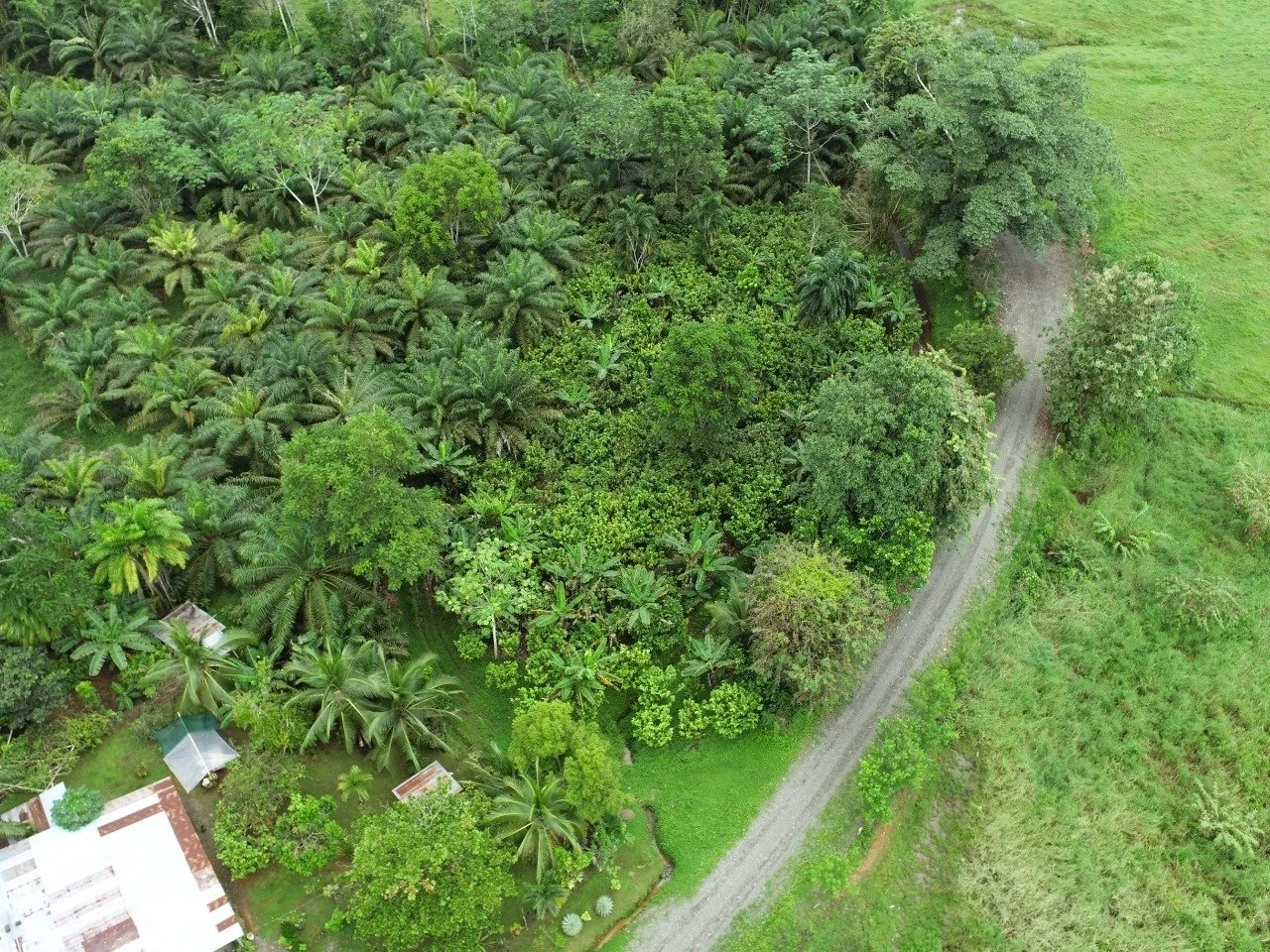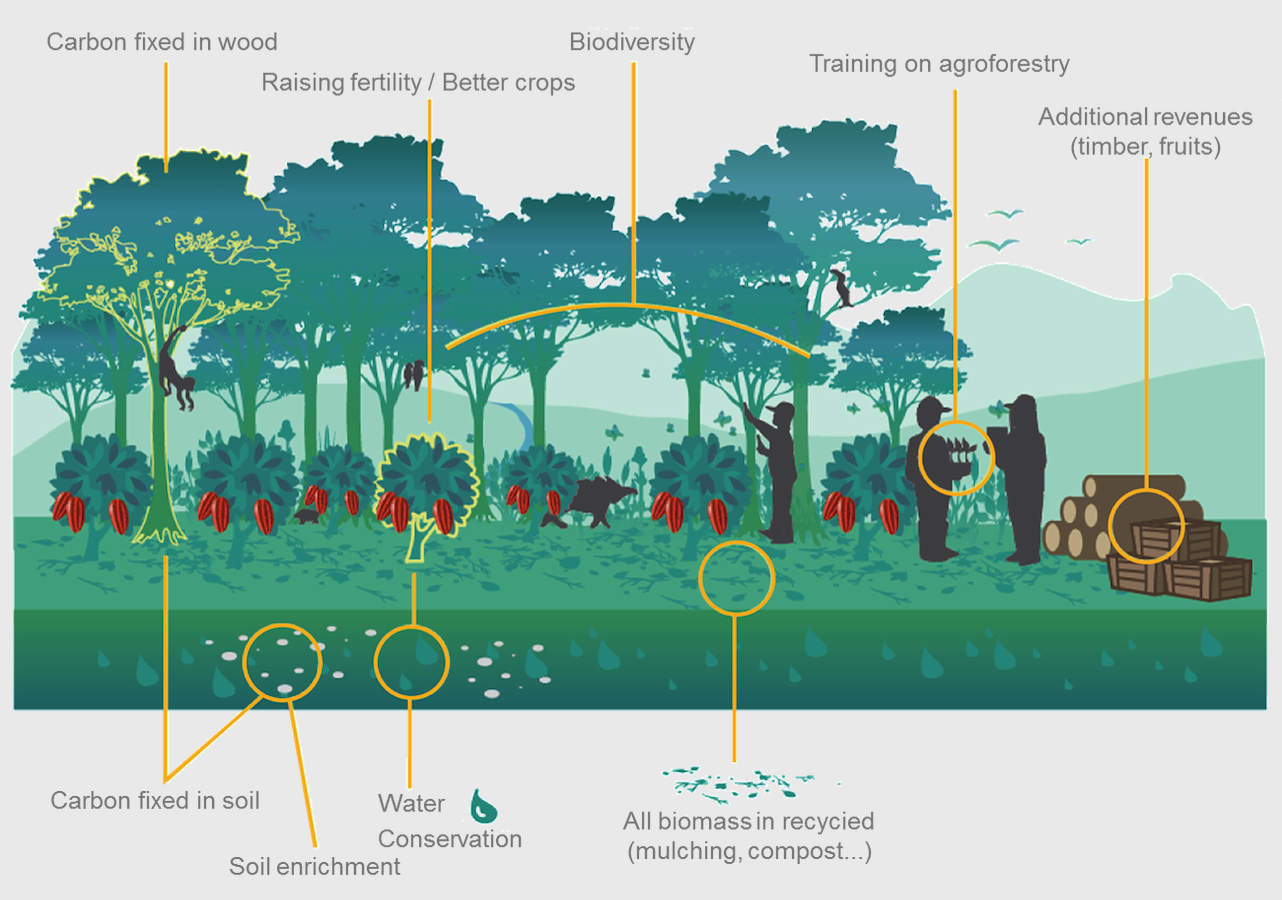Cocoa Agroforestry as Driver for Climate Resilience
- Experiences from Central America
Article based on presentation at ‘Salon del Cacao y Chocolate Latin America’, Peru, October 2021
Figure 1: Areal of smallholder farm in the Osa Peninsula, Costa Rica, with palm oil as primary cash crop
Our land use and food systems have a great impact on problems causing climate change and biodiversity loss. There is a growing need to find ways that combine agricultural production with nature conservation, while securing farmers livelihoods.
Primary forests along with their species-rich cover are rapidly decreasing, while agricultural expansion proceeds due to economic growth, an increasing world population, and therewith growing demand for food, especially meat. Agriculture is responsible for the fast majority of deforestation, representing 85% of total forest loss, and contributing to a quarter of global greenhouse gas emissions (Reuters, 2021).
Figure 2: Agriculture as direct driver for worldwide deforestation (Source: WWF)
Agriculture was taken up as part of ‘Nature Day’ at the COP26 U.N. Framework Convention on Climate Change, in Glasgow. Forty-five countries pledged to ‘protect natural environments and combat emissions from agriculture’. Earlier COP26 already pledged on stopping deforestation by 2030, with a strong link to industrial food systems in terms of clearing forests for food production (DownToEarth, 2021). Twenty-six countries committed to change their agricultural policies and invest in the science needed to shift to sustainable farming methods and protecting food supplies against climate change.
Good intentions, but what does this mean for the rural populations living in less developed countries, who largely depend on this agricultural land for their livelihoods? How can we transform the agricultural sector to benefit farmers, the economy and the environment in the battle against climate change?
To find answers to this I will look into agroforestry logics applied in Costa Rica, who use cocoa as a change maker. While the Yorkin community of the Bribri indigenous people in the Alta Talamanca area apply their cosmogony and cultural background in a traditional agroforestry system, the OSACOOP farmers’ cooperative in the Osa Peninsula region use modern knowledge and technologies to change to resilient land use methods, supported by universities and organisation to establish this. Interestingly, in both cases the practice of crop diversification is observed as a basis for climate resilience. In this context, this article seeks to answer: can agroforestry systems with special attention to cocoa cultivation serve as a solution for humans and nature in the battle against climate change?
NICARAGUA
Let’s start with some alarming figures resulting from a large-scale cocoa climate study carried out in Nicaragua, showing the effect of climate change on current cocoa production (Martínez, 2012). The study has predicted the impact of cocoa monoculture and its vulnerability to rising temperatures and drought. The cultivation of cocoa runs an imminent risk if timely measures are not taken to adapt and mitigate climate change.
Figure 3: Changes in the climatic aptitude of cocoa areas in Nicaragua by 2050 (Martínez, 2012)
The climate scenario for Nicaragua in 2050 predicts an increase in temperature of 2.2 o C and a decrease of 100 mm of annual rainfall (Martínez, 2012). This will cause soil depletion and vulnerability to pests and diseases that can kill the crop in two or three years, since cocoa is originally a shade crop that profits from a humid climate.
To secure the future of cocoa, changing production methods are needed to make the crop more resilient to changing weather conditions. Thereby protecting the farmers' livelihoods and national economies that thrive from it.
COSTA RICA
Costa Rica is one of the most biodiverse countries on the globe, representing almost 6 percent of the planet's biodiversity. The Costa Rican government and other organizations have been making numerous efforts to protect their natural treasures from degradation and forest loss, one of the main drivers of climate change. However, the government has taken little consideration to the consequences for the agricultural sector, threatening numerous smallholders in the area.
THE OSACOOP CASE
6 years ago I lived on a palm oil farm in the Osa Peninsula to study farmers' land use opportunities in the Golfo Dulce Forest Reserve. Since then, I am in close contact with the farmers’ Cooperative, OSACOOP, and follow their search and efforts to live from their land while respecting the natural ecosystem they are part of. In the last years OSACOOP has given a lot of emphasis on setting up agroforestry systems, to strengthen farmers' resilience and reduce agricultural risks on the natural environment.
Figure 4: Agroforestry demo plot at OSACOOP R.L.
The OSACOOP case can serve as a micro example of human-nature coexistence and seeks to find a balance in which both can subsist or even complement each other to adapt to climate change and combat future pandemics.
LAND USE ACTIVITIES AND STRUGGLES FOR SUBSISTENCE
The agricultural sector in this region has faced boom-bust cycles of production and has generally been an unstable source of income. Farmers have changed their production over time from cocoa to corn, beans, rice and cattle and later palm oil.
Farmers started to experience more and more the threat of monoculture cultivation on their livelihoods because of the risk of low market prices, an increasing risk of pests, and on top of that soil depletion. As a consequence, monoculture cultivation requires an increasing need for chemicals and pesticides, obtaining new fertile land and an increase of production to compensate for the low market prices. Overall, putting a great risk on deforestation (López Espinoza and Potma, 2020). With the growing effects of climate change, there are longer periods of droughts and biodiversity levels are decreasing. Turning monocropping into a vicious cycle of threats to both people and nature.
Figure 5: Effects of bad land management vs ecosystem restoration activities (Source: Ecosystem restoration camps)
The complex relationship between nature and humans on the Osa Peninsula requires care and alternative means of production. Alexander Solórzano, director of farmers’ cooperation OSACOOP, explains that:
““We are concerned about our environment, and we want to protect it. To keep the natural landscape in balance, we need to find climate-friendly production methods, because otherwise we live in a region with a lot of biodiversity but with many poor people. “”
Figure 6: Areal of palm oil plantation in the Osa Peninsula combined with timber and a small plot of cocoa and banana
COCOA AS DRIVER FOR CONSERVATION RESTORATION
The struggles in Osa highlights the importance to develop alternative income streams, allowing socio-economic growth in a responsible and climate-appropriate way; by introducing new, low-input, sustainable agricultural methods that focus on a better management of natural resources and guide farmers towards responsible land use practices using diversified systems. In this way, farmer’s risks are spread, and environmental impact can be reduced. Which is also necessary in order to continue fulfilling the strict government policies.
To achieve crop diversification, it is necessary to implement the use of techniques that provide restoration to the agricultural landscape and make them more resilient, such as crop rotation or sequential crops, cover crops, intercropping, agroforestry and mixed production systems.
This made OSACOOP farmers start collaborating to set up agroforestry systems at the borders of the Reserve, to spread their risks and reduce their impact on the surrounding nature.
Farmers have started complimenting their palm oil fields with rows of cocoa, plantain, in combination with fruit and/or timber trees. Palm oil and banana have a double function, they function as shade trees for cocoa. The first results show that both palm oil and banana offer higher yields (both in quality and quantity) when grown together compared to growing individually (López Espinoza and Potma, 2020). This suggests that the quality of the soil has improved, and its fertility increased. Which benefits the quality of the cocoa too.
Figure 7: Agroforestry design for OSACOOP with cocoa as the basis of the system (source: PRETA TERRA)
Recently, some farmers have started implementing vanilla in the system, which generates a high price on the world market, but also carries greater risks to achieve a good harvest (López Espinoza and Potma, 2020). However, the other two commercial crops of palm oil and cocoa are quite stable and provide resilience to the vanilla. Alexander adds,
"The system offers reliability of yield, cocoa can be seen as a subsidy in times when vanilla prices are bad."
Farmers no longer need to abandon the production of one crop when market prices are low, they now have other crops to turn to.
Within this system, cocoa fulfills multiple functions, in addition to helping with climate adaptation and diversification of palm oil production, it offers a stable alternative source of income for the variable vanilla production, and provides farmers with the opportunity to access various markets, both local and international (López Espinoza and Potma, 2020).
But that is not all. Alexander emphasizes the importance of including subsistence crops in the system, since a resilient livelihood does not only depend on cash crops for the market. So they also grow rice, beans, tiquisque and corn for animal fodder.
ANCESTRAL BRIBRI WISDOM FOR CLIMATE RESILIENCE
The South of Costa Rica is home to the Bribri indigenous communities, whose livelihoods are spread from the South Pacific to the Caribbean coast on the Cordillera de Talamanca. Here, most of the territories are primary forests. Embedded in the Bribri culture is a strong belief to spread life on earth and respect everything that exists. For them, their God ‘Sibö̀’ created Earth for the existence and development of life. Therefore, its destruction would threaten everything that exists in it, including themselves (López Espinoza, 2021). This belief created the basis for their agricultural production system, an agricultural life cycle characterized by abundance and based on respect for all forms of life.
The Bribri’s production spaces are divided in different levels (Teitö, Chamugrö and Witö) to protect the ecosystem and the soil. The variety of crops, combining timber at the higher levels with fruit trees in the middle and tubers, vegetables and grains at the lower levels, look like a typical agroforestry model. But the Bribris use their ancestral practices of conservation and regeneration to reflect their holistic view on the world (López Espinoza and Potma, 2020). Thereby, they don’t plow the soil nor make use of agrochemicals. Respecting the life cycles and decompose what dies to let it return to where it came from.
Figure 8: Traditional layered Bribri production system
Cocoa has a special significance in Bribri culture. For them the cacao tree used to be a woman who ‘Sibö̀’ (God) turned into a tree. Therefore, cocoa branches are never used as firewood and only women are allowed to prepare and serve the sacred drink. Currently there exists several Bribri women’s associations that produce organic, handmade chocolate that helps them in their livelihoods. The Yorkin Bribris have been exporting their cocoa and banana to Switzerland and Italy for over 20 years, a sign that ancestral indigenous agriculture is also an agriculture that adds value to international markets and thereby meets the needs of native communities (López Espinoza, 2021).
Figure 9: Bags with organic cocoa in the APPTA collection and processing center, Yorkin (Source: Natalia López Espinoza)
However, the dispossession of territories, the lack of biodiversity protection and current extractive activities performed to commercialize common goods while expelling indigenous groups, are latent threats. While the Bribri knowledge can provide insights on how to deal with climate change through their mitigation and adaptation practices.
COCOA AGROFORESTRY AS A CLIMATE-SMART AGRICULTURE
The above shows that cocoa agroforestry has environmental, social and economic benefits. It provides resilience for livelihood subsistence and landscape restoration, and also functions as a buffer zone around the Forest Reserve and strengthens wildlife corridors increasing biodiversity.
Figure 10: Benefits of an agroforestry system (Source: PUR Project)
The importance of timber in an agroforestry system is not only to improve soil quality and thus crop production, but trees also capture a large amount of carbon stocks and make us more resilient to extreme weather conditions. Depending on the design and the crops used in the system, agroforestry can capture between 0.29 to 15.21 Mg CO2 / ha / year in its leaves and 1.23 to 173 Mg CO2 / ha / year in the soil (López Espinoza and Potma, 2020). Trees represent an important part of the response to mitigate climate change and secure farmers' livelihoods.
SETTING UP COCOA AGROFORESTRY AND ACCESS TO MARKETS
The development towards agroforestry systems is very positive, both for the farmers and their natural surroundings. However, it is very difficult to set these up. Who is going to pay? Currently the farmers are investing more on sustainable production methods than the price they receive on the market for their products.
Most private sector actors are reticent to invest in these new complex systems, and don’t want to take the risk. What if it fails? What if consumers don’t want to pay extra for their products? What to do with the other products that are produced in this system, should they invest in these too? Or search for partners and other markets?
An incentive must be created for the private sector to start investing in agroforestry systems and create awareness among consumers on the importance of buying sustainable and deforestation free products. Here lies an important role for governments, who should bear the first risks and support both private sector actors and the farmers in setting up agroforestry systems. After this first step, the private sector can take over.
In this, there is an important role for new technologies to provide proof of impact on the ground and increase transparency & traceability in the cocoa supply chain. For example, through satellite monitoring deforestation and reforestation can be mapped, and CO2 levels can be measured to create economic incentives for carbon markets.
Figure 11: Agroforestry biomass estimation for carbon credits through Radar and LIDAR (Source: Space4Good)
By digitizing producers, consumers and farmers can get connected. In that way consumers can look into the production chain and get proof of where the products they buy come from, how it’s being produced, and which prices are paid. Creating an incentive to choose these products over non-sustainable products.
Only through strong collaboration will it be possible to transform cocoa supply chains into sustainable, transparent and fair practices. And we will remain able to eat chocolate in the future!
CONCLUSION
Both the Bribri community and the farmers of OSACOOP use cocoa diversification strategies as a holistic approach to be climate resilient. However, their approaches are very different. The Bribri community uses a complex traditional cocoa agroforestry system as a synergetisch concept, one that is embedded in their ancient culture and which strengthens community participation. Because of their strong cultural beliefs a monoculture wouldn’t function. For OSACOOP farmers, however, their transformation to cocoa agroforestry causes more effort, training and conviction. It doesn’t go automatically, since it’s not embedded in their culture, and some farmers are hesitant to change. It’s taking up a lot of time, effort and money to change to this new system.
However, both cases have proven that cocoa is an integral crop in their production systems, enhancing ecosystem resilience and social and economic resilience. In this sense, their adaptive capacity and contribution to mitigating climate change and future pandemics are being improved. Both realizing that nature is an important ally in the fight against climate change.
The current COVID-19 crisis further shows the advantages of applying an agroforestry system that increases resilience to current and future pandemics, providing food security and limiting risks. In the long term, this will become increasingly essential when coping with more extreme weather conditions.
REFERENCES
DownToEarth, 2021. COP26 report card: Agriculture continues to remain subterranean even in Glasgow. URL: https://www.downtoearth.org.in/news/climate-change/cop26-report-card-agriculture-continues-to-remain-subterranean-even-in-glasgow-80180
López Espinoza, N. & Potma, M. (2020) Respuestas agroecológicas para la resiliencia climática. Dos experiencias en Costa Rica. LEISA, Revista de Agroecologia, Volumen 36 (2). URL: https://leisa-al.org/web/index.php/volumen-36-numero-2/4226-respuestas-agroecologicas-para-la-resiliencia-climatica-dos-experiencias-en-costa-rica
López Espinoza, N. (2021) Ancestral Agriculture of the Bribri Ethnic Group. IASC Forest Commons Conference. URL: https://www.youtube.com/watch?v=y3Fqnr5s9y4
Martínez, A. (2012) Cacao y Cambio Climático Nicaragua.
Reuters, 2021. Analysis: Will COP26 deforestation pledge be game-changer or just more broken promises? URL: https://www.reuters.com/article/us-climate-un-forests-analysis-idUSKBN2HN13I
